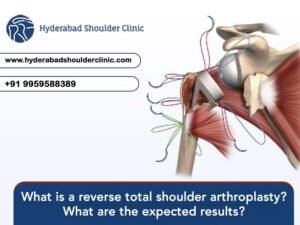A frozen shoulder means that the shoulder has gotten stuck with a limited range of motion. A frozen shoulder is a combination of factors, such as inflammation of the capsule or the tissue surrounding the shoulder joint. One has to undergo physical examination, X-rays or additional tests to rule out other causes of symptoms.
A good shoulder surgeon will try non-surgical treatments at first. Surgery is a later option which is considered only when the non-operative therapies have failed to improve the range of motion and decrease pain.
Why does a frozen shoulder occur?

The shoulder joint is enveloped by a tissue called the capsule that holds it together. The capsule helps in the expansion and contraction of the joint to facilitate various movements of the arm. In the case of a frozen shoulder, capsule inflammation occurs, leading to scarring. These scars are known as adhesions. Due to the scarring and tightening of the capsule, the shoulder movement becomes restricted and painful.
Though the exact cause of the frozen shoulder is not known, it was found that long-term immobilisation of the shoulder after an arm injury, for instance, can lead to a frozen shoulder. Inflammation of the shoulder supporting structures such as tendons and muscles, common with rotator cuff tendinitis or bursitis, can also cause frozen shoulders.
Diagnosis of a frozen shoulder
Expert shoulder surgeons like Dr.Chandra Sekhar B will first get a complete medical history. The patient should also be informed about past injuries, surgeries, level of physical activity and ongoing treatments, if any.
X-rays follow this to rule out other potential causes of a painful shoulder or limited shoulder motion.
The first treatment option for someone with a frozen shoulder


The best shoulder surgeons aim at increasing the range of motion while reducing the pain.
Physical therapy: This therapy is required to increase the range of motion of the arm. One should practise physical therapy under supervision for about one to six weeks and with a frequency of one to three times per week.
They should also do home exercises and stretching throughout the healing process at least once or twice daily. The physical therapist teaches at-home stretching exercises, and the patient is advised to use a cane, overhead pulley, a home pulley system and an elastic cord while doing the exercises. If the patient sticks to the therapy program strictly, the frozen shoulder will resolve almost entirely with time. The path to recovery takes up to six to nine months on a case-by-case basis. The most difficult movements to regain are moving the hand to the back pocket or up the middle of your back. To stimulate the nervous supply and enhance blood circulation, the therapist will also apply ice, heat, ultrasound or electrical stimulation.
A frozen shoulder may take two to nine months to develop. Although the pain may slowly improve, stiffness continues, and the range of motion remains limited.
5 exercises as the first treatment option for someone with a frozen shoulder
Start by warming up your shoulder before the exercises by taking a warm shower or bath for 10 to 15 minutes. Another option is to use a moist heating pad or a damp towel heated in the microwave. Remember that while stretching, go to a point where you feel the stretch, but not if it is painful.
- Pendulum stretch
- Relax your shoulders and lean slightly, allowing your affected arm to hang down.
- Swing the arm in small one-diameter circles for 10 revolutions in each direction. Practice once a day and increase the diameter of your swing, but never force it as you see improvement.
- As you progress, you can repeat the same with light weights of one to two kilograms in the swinging arm.
- Towel stretch
- Hold an approximately three-foot-long towel behind your back with both hands in the horizontal position.
- With the good arm, pull the affected arm upward, causing a stretch.
- As you improve, drape the towel over your good shoulder.
- Practise the towel stretch 10 to 20 times a day.
- Finger walk
- Maintain an arm’s length distance from the wall and reach out and touch the wall at waist level with the fingertips of the affected arm.
- Slightly bend the elbow and walk your fingers up the wall slowly until the arm is at shoulder level. You can go a bit high up, too, if it is comfortable.
- Repeat this exercise 10 to 20 times a day.
- Cross-body reach
- One can do this stretch in both sitting or standing positions.
- With the help of the good arm, lift your affected arm at the elbow, and bring it up and across your body.
- Apply gentle pressure on the shoulder and hold the stretch for 15 to 20 seconds.
- Repeat this exercise 10 to 20 times a day.
- Outward and inward rotation
- Outward rotation: Grasp an exercise band with your elbows at a 90-degree angle close to your sides. The lower part of the affected arm must be rotated outward two or three inches and held for five seconds.
- Inward rotation: Stand beside a closed door and hook an exercise band around the doorknob.
Hold the other end with the affected arm, maintaining the elbow at a 90-degree angle.
In this position, pull the band toward your body two or three inches and stretch for five seconds.
Repeat both movements 10 to 15 times once a day.
Pain reduction: Due to the inflammation of the shoulder supporting structures, the patient has pain based on which stage of the frozen shoulder the patient is in. Pain reduction medication includes anti-inflammatory medications. Some patients experience pain after the physical therapy session. In such cases, pain medication helps to decrease the pain and sleep at night.
If the pain is still not manageable, steroid injections of the joint or the bursa may be indicated.
When is surgery for a frozen shoulder recommended?
If the above program does not improve the range of motion and decrease the pain, then surgery may be indicated. After the patient has had a general or regional anaesthetic, the physician may manipulate the shoulder in the operating room to break down the scarring. Occasionally, an arthroscope (a small instrument with an attached camera placed into the shoulder through a small puncture-type incision) is used to cut or release the capsular adhesions directly. Most patients begin physical therapy the same day of the manipulation or the following day.
Other operations, such as removing spurs, may also be indicated or required during the manipulation. These operations can sometimes be done with the arthroscope but may require one or two larger incisions around the shoulder (open surgery).
Stiffness that worsens at first but gradually begins to improve over time, dull, aching pain that increases as the disease progresses, and may worsen when you move your arm.
We at Hyderabad Shoulder Clinic, always take up non-surgical treatment options first. We carefully design the physical therapy regime and monitor the progress. For more information, please visit our website https://hyderabadshoulderclinic.com/ or contact us at +91 9959588389 or shoulderandsportsclinic@gmail.com





